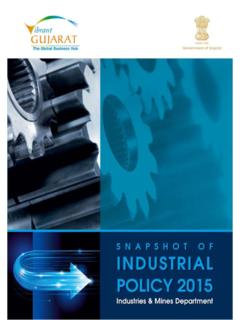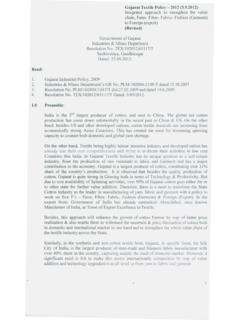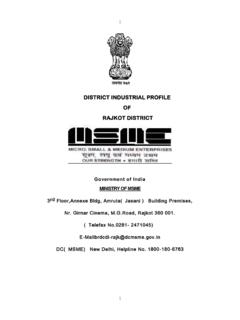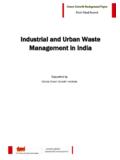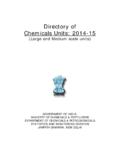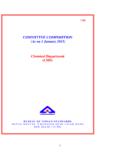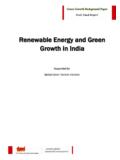Transcription of Gujarat Pollution Control Board
1 ENVIRONMENTAL AUDIT SCHEME. AND. THE GUIDELINES FOR ENVIRONMENTAL AUDITORS. (YEAR 2006). Gujarat Pollution Control Board Paryavaran Bhavan, Sector 10-A, Gandhinagar 382 043. PREFACE. The state of Gujarat has natural advantages like abundance of some minerals longest coastline, number of ports etc. Besides this; easy availability of labour; peaceful industrial climate & the business acumen of the people coupled with promotional policy of Government an infrastructural facilities like power, water land and transportation lead to rapid industrialization along the golden corridor and other parts of the state. The development process was at its peak during 90's. This phenomenal growth of industries had some ill effects on environment. The state realized about these problems and was trying to tackle this issue with limited man power and infrastructure. Meanwhile; agitated by the discharge of waster water from various chemical industries situated in the industrial estates of Ahmedabad; the farmers moved Gujarat High Court through a public interest litigation in 1995.
2 During hearing of the public interest litigation the High Court observed that enforcing agencies were able to monitor; large number of industries scattered over different parts of the state to a limited extent only. The Hon'ble High Court therefore thought in the interest of Justice to introduce the Environmental Audit Scheme vide the order dated 20-12-96 for industries manufacturing specified products; where qualified technical professional would become a link between the individual industries on one hand and the GPCB and other public authorities as well as association of industries on the other hand; with the added vital elements of accountability and transparency. Subsequently two more orders were passed by the Hon. High Court on 13-3-1997 and finally on 16-9-1999. This scheme is being implemented by the Board as per the directions of the Hon. High Court issued through all the orders stated above. The Board has recognized auditors in accordance with the criteria fixed by the Board ; prepared format for submission of Environmental Audit Reports; made all stakeholders aware about the Scheme; devised format for submission of adequacy and efficacy certificate about the Environmental Management System of the industry.
3 With the help of technical committee; all auditors of environmental audit; the compliance with reference to man power and laboratory facilities of all auditors are regularly ascertained by the Board . In case of violation by any industry or auditor the punitive action are also taken. This scheme is functioning well from last about 10 years with the working of the schedule I and schedule - II industries by auditors recognized by GPCB. They are required to monitor and evaluate the Environmental Management System (EMS) , suggest and recommend for the improvement of EMS in industry. There are, certain positive case studies carried out by the auditors, which reflect the success of the scheme. Much more is required to improve the quality of the auditing and EMS system to fulfill the aim and goal. INDEX. Particulars Page No. 0. Environmental Audit 1. 1. Objective of Scheme 1. 2. Terminology 1. 3. Environmental Audit Scheme- Applicability of 2. Scheme 4. Eligibility for Environmental Auditor 3.
4 5. The Guidelines to be followed by Schedule I & 4. II Auditors. 6. List of Auditors. 6. 7. Complaints against Auditor. 6. 8. Action/Direction upon filling of Audit Reports 6. 9. Action/Direction upon filling of Audit Reports 7. 10. Consequences of failure to file Audit Report. 8. 11. Notes as per order dated 13-3-97 below 8. schedule I & II. 0. ENVIRONMENTAL AUDIT SCHEME. Environmental audit is a management tool comprising of a systematic, documented, periodic and objective evaluation of how well the Environment management systems are performing with the aim of, Waste prevention and reduction. Assessing compliance with regulatory requirements. Facilitating Control of environmental practices by a company's management and placing environmental information in the public domain. 1. OBJECTIVE OFSCHEME. The scheme was introduced with a view to: Enforcing discipline amongst the industries Arming GPCB as well as the Associations of industries in the concerned areas with the necessary information and, Doing regular monitoring of different industries scattered in the entire State of Gujarat with a perspective of environmental protection, & sustainable development.
5 2. TERMINOLOGY. For the purpose of Environmental Audit the following terminologies are used. Auditor shall mean Environmental auditor recognized by the Gujarat Pollution Control Board . Audit Report or Report' shall mean Environmental Audit Report required to be submitted under the Scheme in the prescribed format. Environmental Management System shall include treatment plants, equipments and processes for liquid effluents, air emissions, noise, solid wastes and other pollutants. Also collection, treatment, conveyance and disposal system for such wastes and other pollutants. An environmental audit may include environmental compliance audits, environmental site assessments, environmental risk assessments including safety & health aspects, EMS gap assessments, EMS audits, and/or internal EMS audits, with reference to pollutants. Schedule means Schedule to this Scheme, as approved by the Hon'ble High Court & modified by GPCB from time to time. Specified Industries shall mean industries manufacturing/processing any one or more of the products mentioned in Schedule I or Schedule II of the Hon'ble High Court order dated 13-3-97.
6 Specified Product shall mean products/processes specified in Schedule I or Schedule II of this Scheme. GPCB shall mean Gujarat Pollution Control Board . NEERI shall mean National Environmental Engineering Research Institute. ATIRA shall mean Ahmedabad Textile Industry's Research Association. MANTRA shall mean Man Made Textiles Research Association. AQC shall mean Analytical Quality Control . ASC shall mean Acetyal Sulphanyl Chloride. CPC shall mean Copper Pthelo Cynyne. ETP shall mean Effluent Treatment Plant. CETP shall mean Common Effluent Treatment Plant. TSDF shall mean treatment stabilization Disposal Facility. Audit Team: An Audit team shall consist of 4 persons in the form of an Environmental Engineer, a Chemical Engineer, a Micro biologist and a Chemist. The details in this regard are mentioned elsewhere in the guidelines. 3 ENVIRONMENTAL AUDIT SCHEME. Applicability of the Scheme: (a) This Scheme shall apply to all the industrial units manufacturing and/or processing any one or more of the products mentioned in Schedule I and/or Schedule II to this Scheme, and situated in the State of Gujarat .
7 (b) Any product the manufacture of which consumes the same or substantially the same raw materials consumed for the manufacture of any of the aforesaid mentioned items/products is same or substantially similar; shall also be considered to be a specified product within the meaning of this Scheme. (c) An industrial unit which is manufacturing or processing any of the specified products under orders of trial production (whether passed by Hon. Court or any authority) is also covered by this Scheme. (d) All common facilities CETPs /TSDFs etc of the state. (e) All other industries manufacturing products which are included by the Board in Schedule I or Schedule II as per Annexure C. 4. ELIGIBILITY CRITERIA FOR AN ENVIRONMENTAL AUDITOR. The applicant must have manpower; experience, qualifications and laboratory facilities as stated under to qualify for an Environmental Auditor. a) Qualification : Each Audit team must comprise of at least four member;. having following qualification.
8 I) A person possessing a degree in Environmental Engineering or a degree in Civil Engineering with specialization in Environmental Engineering as an elective subject awarded by the recognized University or Institute in India or abroad. And ii) A person possessing a degree in Chemical Engineering/Technology awarded by a recognized University or Institute in India or abroad. And iii) A person possessing a degree in Chemistry or Environmental Science awarded by a recognized University or Institute in India or abroad. And iv) A person possessing a degree in Micro Biology/Bio-chemistry awarded by a recognized University or Institute in India or abroad. b) Experience: Out of four members at least one Engineer (Chemical or Environmental) and one scientist (Chemistry or Microbiologist) should have a minimum experience of ONE YEAR in the field of the Environmental Management System, in a chemical industry. c) Number of teams: An Auditor can have maximum three numbers of teams for audit work having man power, qualifications and experience as shown at (a) and (b).
9 In other words no auditor shall have more than three teams having above stated qualifications and experience for the team members. d) Number of Audits No auditor shall take up more than fifteen Environmental Audit jobs per team and maximum numbers of Environmental Audit jobs to be submitted by each auditor per year shall not exceed forty five under any circumstances;. irrespective of number of teams and/or team members. e) Laboratory : i) Space: Each auditor must have an adequate laboratory having an area of minimum 30 Sq m for one team; 40 sq m for two teams and 50 sq m for three teams. ii) Instruments/parameters: The applicant shall have self reliant laboratory with duly calibrated all necessary and required instruments as per annexure A and shall have qualified and trained human resources so as to analyze the parameters shown in list annexed as per annexure B. f) Recognisation: Each auditor whether Schedule I or Schedule II must have valid recognisation from GPCB from time to time depending upon the validity of registration.
10 No auditor shall submit Environmental Audit Report for and industry if he is derecognized as such report will not be accepted by the Board . 5. THE GUIDELINES TO BE FOLLOWED BY SCHEDULE I & II AUDITORS. THE FOLLOWING CONDITONS MUST BE FOLLOWED BY THE AUDITORS. WHILE CARYING OUT THE ENVIRONMENTAL AUDIT ? OF INDUSTRIES /. COMMON FACILITIES FALLING IN SCHEDULE I AND II OF THE HON'BLE. HIGH COURT ORDER DATED 13-3-97 & ALL OTHERS AS PER THE GPCB. DIRECTIONS ISSUED FROM TIME TO TIME. 1. All the audit reports are to be submitted as per the format prescribed by the GPCB as per Annexure F. 2. The EARs prepared and submitted by the auditors must be accompanied by adequacy & efficacy certificate in a format prescribed by GPCB failing which the respective industry & auditor shall be held responsible; & EAR shall not be accepted. This may also lead to derecognisation of auditor and action as per para 10(a) of the High Court order dated 20-12-96 against the industries. 3. The EARs must include at least three observations covering all the three seasons.





